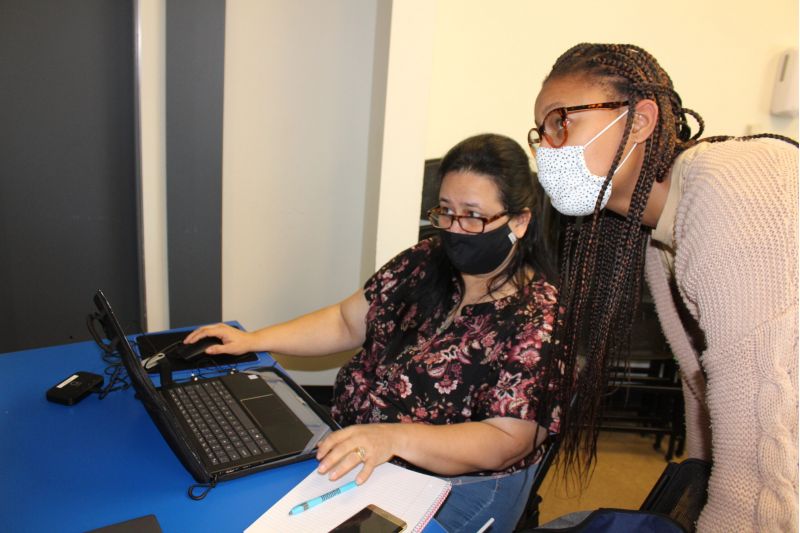Checking in on Progress Toward a More Equitable Workforce

In the years since COVID-19 reached our region, North Texas workers have continued to feel the broad-reaching effects of the pandemic. Across North Texas, many of our neighbors have been unable to find and keep good-paying jobs, and every new wave of the virus has brought fresh layoffs and uncertainty.
In the midst of these workforce challenges, in early 2021 United Way of Metropolitan Dallas partnered with national research and action institute PolicyLink and the National Fund for Workforce Solutions to publish “Advancing Workforce Equity in Dallas and Collin Counties: A Blueprint for Action.” The report identifies the array of obstacles workers of color face in the local labor market, as well as steps that are required to ensure these workers can readily enter and advance in the North Texas workforce.
In the 18 months since the report’s release, our region has made some significant gains in its employment statistics. However, many challenges remain—especially for women and workers of color.
At United Way of Metropolitan Dallas, income has always been one of our areas of focus, because we understand the importance of financial stability and a good-paying job in a person’s life. As our world has been reshaped by COVID-19, we’re more committed than ever to developing and investing in workforce programs that will provide a path forward for our hardworking neighbors.
Together with our committed supporters, we continually work to improve workforce equity throughout North Texas. And in the face of evolving difficulties, our initiatives are having a real impact on local workers and their families.
Progress Since the Start of COVID-19
When COVID-19 hit North Texas, our region’s workforce was devastated. Local unemployment hit a peak of 13.5% in April 2020. Women and workers of color were affected the most, because they tend to work in industries and jobs that were hit the hardest, such as food service and hospitality.
In the two years since, unemployment has gradually improved, according to the Texas Workforce Commission. Take a look at how this year’s most recent unemployment statistics compare to the two previous years:
- June 2020 unemployment: 10%
- June 2021 unemployment: 5.7%
- June 2022 unemployment: 3.8%
While these numbers are encouraging overall, the effects of the pandemic are still all too real for many of our neighbors.
Our Workforce Doesn’t Benefit All North Texas
Unfortunately, many of the racial disparities that COVID-19 highlighted in our local workforce have persisted even as our unemployment figures have improved. According to the National Fund for Workforce Solutions, our region’s Racial Equity Index ranking is 27th out of the 150 largest metro regions in the U.S. That means for people of color, 123 metropolitan areas offer better access to high-quality education and training opportunities, family-sustaining wages, and employment for those who want to work.
Greg Mangum, vice president of economic mobility at United Way of Metropolitan Dallas, affirms that workers of color in North Texas tend to have fewer pathways to good-paying jobs available. Plus, they’re more likely to have their careers impacted by external factors, such as access to childcare, transportation and digital literacy skills.
The “Advancing Workforce Equity” report explored several key trends that often limit job opportunities for workers of color in particular:
- The workforce is deeply segregated. Despite the growing diversity of the workforce in Dallas and Collin counties, workers of color are crowded in lower-paying and lower-opportunity occupations; white workers are overrepresented in many higher-paying professions.
- North Texas has a shortfall of good jobs that do not require college degrees. Overall, only 40% of workers are in jobs that are stable, are not at risk for automation and pay family-sustaining wages. That number drops to just 12% for those in jobs that require only a high school diploma.
- Racial economic exclusion hampers the region’s economic growth. If racial gaps in wages and employment for workers could be closed, our region’s GDP would increase by 35%. With racial equity in pay, the average annual income of Black workers would double; Latinx workers would fare even better.
The report concludes that although people of color make up the majority of the region’s workers, they do not share equitably in its economic prosperity. More than 60% of workers ages 25 to 64 in Dallas and Collin counties and people of color. But Black and Latinx workers are about twice as likely as their white counterparts to be economically insecure.
Meanwhile, the cost of living has increased over the last few years. According to the Massachusetts Institute of Technology’s living wage calculator, a childless adult living in Dallas County needs to make $17.81 an hour to cover basic expenses and have a little money saved for emergencies. This number jumps to $33.62 if that person has a child. (Just last year, the hourly living wages were significantly lower—$15.98 for a childless adult and $31.94 for an adult with one child—proof that the cost of living has risen sharply in our community.)
“Since the start of the pandemic, everything has gotten more expensive, but wages have remained stagnant,” Mangum said. “And the workers of color in our community are up against enormous odds to find stable, good-paying jobs. That not only holds back individuals and their families; it holds back our entire community. It’s up to all of us to create and improve pathways to living wage jobs so that all of North Texas can prosper.”
United Way Improves Workforce Equity
In the “Advancing Workforce Equity” report, United Way and our partners found that we need a community-wide effort to improve racial equity in our workforce. Key steps to achieving this goal include:
- Increase good jobs available for frontline workers of color
- Increase the number of workers of color in pre-apprenticeships and apprenticeships
- Use skills-based hiring strategies to reduce occupational segregation
- Invest in digital literacy, adult literacy and integrated learning programs to reduce barriers to entry in the labor market
- Increase investments in supportive resources like accessible childcare, affordable housing and efficient transportation
At United Way of Metropolitan Dallas, we’ve taken these recommendations to heart, expanding our existing workforce initiatives and launching new efforts to improve equity in our region’s workforce.
In the 18 months since the report was published, we’ve taken several important steps to encourage workforce equity, including:
- Digital Connections: We’re working to bridge the “digital divide” by providing jobseekers and workers with access to digital literacy training, computer devices and internet service.
- Career Pathways Learning Network: We’re building the capacity of adult literacy providers to better connect education programs to real-world employment outcomes.
- Journey mapping: We partnered with SMU School of Design and Innovation to document the experiences of people of color who utilize local workforce development resources. The report identified opportunities to improve workers’ experiences, including providing career counselors, closing the immigration credential gap, delivering consistent digital experiences, providing coaching through transferable skills sets and building good communication networks.
- Skills-Based Hiring Lab: We’re also providing resources and training for employers that are seeking to use more inclusive hiring criteria and practices.
In addition to these newer efforts, we also lead and facilitate the following programs that ensure workers of color can access good-paying jobs:
- Pathways to Work, which provides training and credentialing programs to help hard-working North Texans get better-paying jobs in the high-demand fields of IT and healthcare. Most recently, our Pathways to Work healthcare partnership has helped to improve access to living-wage career opportunities in healthcare while also working to improve job quality for frontline workers.
- Women in Construction, which is part of our Southern Dallas Thrives initiative, a partnership with United Way, PepsiCo Foundation and Frito-Lay North America. In partnership with Hilti North America, Women in Construction seeks to attract more women to the fast-growing construction industry by providing them with training and wrap-around services, such as childcare and transportation.
- The Women’s Workforce Readiness Initiative, a partnership with CitySquare through Southern Dallas Thrives. The initiative provides 550 Dallas-area women with the social support and technical and soft-skills training needed to secure employment in high-growth industries such as advanced manufacturing and logistics, sales and marketing, and food and hospitality management.
Be Part of the Change
Income is an area that affects our entire economy. When more North Texans prosper, our region as a whole enjoys greater prosperity. In fact, if we can increase by 20% the number of young adults who earn a living wage, we’ll add nearly $800 million to our local economy. And it is our goal to do just that by the year 2030, as part of our Aspire United 2030 goals—our North Star for driving progress in the areas of education, income and health over the next decade.
We invite you to join our movement and create opportunity for all North Texans. You can have a direct impact on workforce development in our region by:
- Volunteering to be a digital literacy coach. You’ll coach and motivate digital learners with tasks such as setting up an Indeed and LinkedIn profile and alerts, navigating through Microsoft Office programs, and other various professional technology skills.
- Making a donation to United Way, which will help support workforce development initiatives like the ones outlined above.


